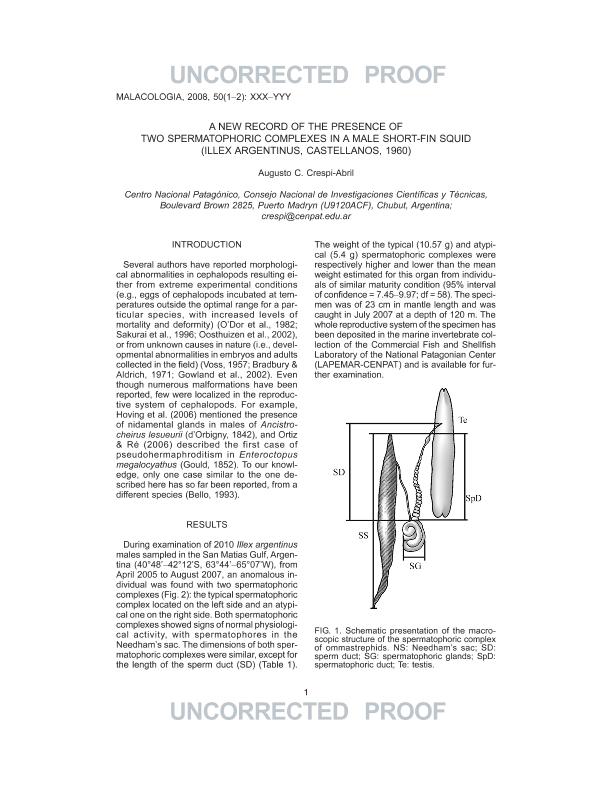Artículo
A New Record Of The Presence Of Two Spermatophoric Complexes In A Male Short-Fin Squid (Illex argentinus, Castellanos, 1960)
Fecha de publicación:
12/2008
Editorial:
Institute of Malacology
Revista:
Malacologia
ISSN:
0076-2997
Idioma:
Inglés
Tipo de recurso:
Artículo publicado
Clasificación temática:
Resumen
Several authors have reported morphological abnormalities in cephalopods, resulting either from extreme experimental conditions (i.e. eggs of cephalopods incubated at temperatures outside the optimal range for a particular species results in increased levels of mortality and deformity) (O’Dor et al., 1982; Sakurai et al., 1996; Oosthuizen et al., 2002), or from unknown causes in nature (i.e. developmental abnormalities in embryos and adults collected in the field) (Voss, 1957; Bradbury & Aldrich, 1971; Gowland et al., 2002). Even though numerous malformations have been reported, few were localized in the reproductive system of cephalopods. For example, Hoving et al. (2006) mentioned the presence of nidamental glands in males of Ancistrocheirus lesueurii (D’Orbigny, 1842), and Ortiz & Ré (2006) described the first case of pseudohermaphroditism in Enteroctopus megalocyathus (Gould, 1852). To our knowledge, only one case similar to the one described here has so far been reported, from a different species (Bello, 1993). Results During examination of 2010 Illex argentinus males sampled in the San Matias Gulf (40°48’-42°12’S, 63°44´-65°07´W ) from April 2005 to August 2007, an anomalous individual was found with two spermatophoric complexes (Fig. 2): the typical spermatophoric complex located in the left side and an atypical one in the right side. Both spermatophoric complexes showed signs of normal physiological activity, presenting spermatophores in the Needham’s sac. The dimensions of both spermatophoric complexes were similar, except for the length of the sperm duct (SD) (Table 1). The weight of the typical (10.57 g) and atypical (5.4 g) spermatophoric complexes were respectively higher and lower than the mean weight estimated for this organ from individuals of similar maturity condition (95% interval of confidence = 7.45 – 9.97; df = 58). The specimen was of 23 cm in mantle length and was caught in July 2007 at a depth of 120 m. The whole reproductive system of the specimen has been deposited in the marine invertebrate collection of the Commercial Fish and Shellfish Laboratory of the National Patagonian Center (LAPEMAR-CENPAT) and is available for further examination. Discussion One aspect of reproduction that all cephalopods seem to have in common is that they are gonochoristic; that is that sex is determined genetically; individuals develop as males or females and remain the same sex throughout their life (Nesis, 1987). In Coleoidea, the reproductive system of males is generally formed by one duct and one testis. The ectodermal part of the duct gives rise to the spermatophoric complex (SCo) in males and to the oviductal glands in females, and the mesodermal part develops into the proximal vas deferens in males and proximal oviduct in females (Mangold, 1987). The sperm is produced in the testis and mature spermatozoa are shed into the proximal portion of the vas deferens where, in the convoluted and glandular tubing of the spermatophoric organ (sperm duct), they are packaged into spermatophores and stored in the spermatophoric (Needham’s) sac (Fig. 1). The terminal portion of the vas deferens becomes free from the body surface shortly before its ending just within the mantle opening on the left side (Boyle & Rodhouse, 2005). In the particular case of Oegopsida, the male’s genital ducts are mostly single and situated on the left side, except for members of the family Histioteuthidae and the genera Lycoteuthis, Selenoteuthis and Oregoniateuthis (Lycoteuthidae), which possess paired genital ducts (Nesis, 1987). Particularly in Calliteuthis dofleini (Histoteuthidae) double hectocotyli are also present (Nesis, 1987). As mentioned by Chun (1910), this condition may perhaps be regarded as primary, from which the asymmetry of other Oegopsida developed secondarily. Amongst the factors affecting the normal development of the reproductive system of aquatic species, temperature fluctuation (Devlin & Nagahama, 2002) and infection by viruses, and parasites (Pinn et al., 2001) are the most thoroughly studied. Particularly in mollusks, pollutants are well known for causing malformations in the reproductive system (i.e. imposex caused by Tributyltin), but their effects have been described in detail mainly in gastropods (Bryan et al., 1986; Bryan et al., 1988; Bryan & Gibbs, 1991; Bettin et al., 1996; Oberdörster & Cheek, 2001; Goldberg et al., 2004; Bigatti & Carranza, 2007). There is evidence that cephalopods can bio-accumulate contaminants such as heavy metals by both food and water (Miramand & Guary, 1980; Miramand & Bentley, 1992). Gerpe et al. (2000) have shown that I. argentinus is not an exception to this rule, they are bio-accumulating heavy metals (Zn, Cu, Cd, and Hg) in the digestive gland, gonad and mantle. However, for the specimen analyzed in the present study, lack of knowledge of possible sources of contamination during handling and preservation would make determinations of pollutant concentration unreliable.
Palabras clave:
ILLEX ARGENTINUS
,
SPERMATOPHORIC COMPLEX
Archivos asociados
Licencia
Identificadores
Colecciones
Articulos(CCT-CENPAT)
Articulos de CTRO.CIENTIFICO TECNOL.CONICET - CENPAT
Articulos de CTRO.CIENTIFICO TECNOL.CONICET - CENPAT
Citación
Crespi Abril, Augusto Cesar; A New Record Of The Presence Of Two Spermatophoric Complexes In A Male Short-Fin Squid (Illex argentinus, Castellanos, 1960); Institute of Malacology; Malacologia; 50; 1; 12-2008; 347-350
Compartir
Altmétricas




